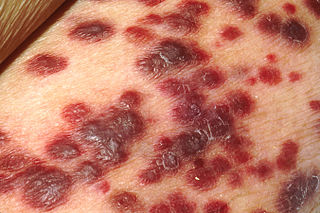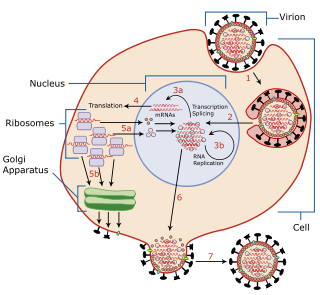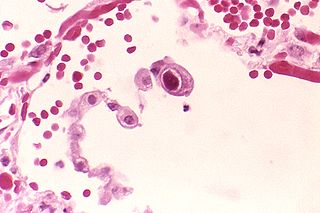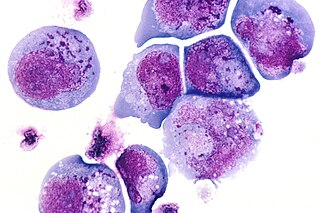Related Research Articles

The Epstein–Barr virus (EBV), formally called Human gammaherpesvirus 4, is one of the nine known human herpesvirus types in the herpes family, and is one of the most common viruses in humans. EBV is a double-stranded DNA virus. Epstein–Barr virus (EBV) is the first identified oncogenic virus, which establishes permanent infection in humans. EBV causes infectious mononucleosis and is also tightly linked to many malignant diseases. Various vaccine formulations underwent testing in different animals or in humans. However, none of them were able to prevent EBV infection and no vaccine has been approved to date.

Kaposi's sarcoma-associated herpesvirus (KSHV) is the ninth known human herpesvirus; its formal name according to the International Committee on Taxonomy of Viruses (ICTV) is Human gammaherpesvirus 8, or HHV-8 in short. Like other herpesviruses, its informal names are used interchangeably with its formal ICTV name. This virus causes Kaposi's sarcoma, a cancer commonly occurring in AIDS patients, as well as primary effusion lymphoma, HHV-8-associated multicentric Castleman's disease and KSHV inflammatory cytokine syndrome. It is one of seven currently known human cancer viruses, or oncoviruses. Even after many years since the discovery of KSHV/HHV8, there is no known cure for KSHV associated tumorigenesis.
Viral pathogenesis is the study of the process and mechanisms by which viruses cause diseases in their target hosts, often at the cellular or molecular level. It is a specialized field of study in virology.

Lysogeny, or the lysogenic cycle, is one of two cycles of viral reproduction. Lysogeny is characterized by integration of the bacteriophage nucleic acid into the host bacterium's genome or formation of a circular replicon in the bacterial cytoplasm. In this condition the bacterium continues to live and reproduce normally, while the bacteriophage lies in a dormant state in the host cell. The genetic material of the bacteriophage, called a prophage, can be transmitted to daughter cells at each subsequent cell division, and later events can release it, causing proliferation of new phages via the lytic cycle.
Virus latency is the ability of a pathogenic virus to lie dormant within a cell, denoted as the lysogenic part of the viral life cycle. A latent viral infection is a type of persistent viral infection which is distinguished from a chronic viral infection. Latency is the phase in certain viruses' life cycles in which, after initial infection, proliferation of virus particles ceases. However, the viral genome is not eradicated. The virus can reactivate and begin producing large amounts of viral progeny without the host becoming reinfected by new outside virus, and stays within the host indefinitely.
HHV Latency Associated Transcript is a length of RNA which accumulates in cells hosting long-term, or latent, Human Herpes Virus (HHV) infections. The LAT RNA is produced by genetic transcription from a certain region of the viral DNA. LAT regulates the viral genome and interferes with the normal activities of the infected host cell.

Herpesviridae is a large family of DNA viruses that cause infections and certain diseases in animals, including humans. The members of this family are also known as herpesviruses. The family name is derived from the Greek word ἕρπειν, referring to spreading cutaneous lesions, usually involving blisters, seen in flares of herpes simplex 1, herpes simplex 2 and herpes zoster (shingles). In 1971, the International Committee on the Taxonomy of Viruses (ICTV) established Herpesvirus as a genus with 23 viruses among four groups. As of 2020, 115 species are recognized, all but one of which are in one of the three subfamilies. Herpesviruses can cause both latent and lytic infections.

Human Herpes Virus (HHV) Infected Cell Polypeptide 0 (ICP0) is a protein, encoded by the DNA of herpes viruses. It is produced by herpes viruses during the earliest stage of infection, when the virus has recently entered the host cell; this stage is known as the immediate-early or α ("alpha") phase of viral gene expression. During these early stages of infection, ICP0 protein is synthesized and transported to the nucleus of the infected host cell. Here, ICP0 promotes transcription from viral genes, disrupts structures in the nucleus known as nuclear dots or promyelocytic leukemia (PML) nuclear bodies, and alters the expression of host and viral genes in combination with a neuron specific protein. At later stages of cellular infection, ICP0 relocates to the cell cytoplasm to be incorporated into new virion particles.

Herpes simplex virus1 and 2, also known by their taxonomic names Human alphaherpesvirus 1 and Human alphaherpesvirus 2, are two members of the human Herpesviridae family, a set of viruses that produce viral infections in the majority of humans. Both HSV-1 and HSV-2 are very common and contagious. They can be spread when an infected person begins shedding the virus.

Gammaherpesvirinae is a subfamily of viruses in the order Herpesvirales and in the family Herpesviridae. Viruses in Gammaherpesvirinae are distinguished by reproducing at a more variable rate than other subfamilies of Herpesviridae. Mammals serve as natural hosts. There are 43 species in this subfamily, divided among 7 genera with three species unassigned to a genus. Diseases associated with this subfamily include: HHV-4: infectious mononucleosis. HHV-8: Kaposi's sarcoma.

Viral entry is the earliest stage of infection in the viral life cycle, as the virus comes into contact with the host cell and introduces viral material into the cell. The major steps involved in viral entry are shown below. Despite the variation among viruses, there are several shared generalities concerning viral entry.
A helper dependent virus, also termed a gutless virus, is a synthetic viral vector dependent on the assistance of a helper virus in order to replicate, and can be used for purposes such as gene therapy. Naturally-occurring satellite viruses are also helper virus dependent, and can sometimes be modified to become viral vectors.

Human betaherpesvirus 5, also called human cytomegalovirus (HCMV,HHV-5), is a species of virus in the genus Cytomegalovirus, which in turn is a member of the viral family known as Herpesviridae or herpesviruses. It is also commonly called CMV. Within Herpesviridae, HCMV belongs to the Betaherpesvirinae subfamily, which also includes cytomegaloviruses from other mammals. CMV is a double-stranded DNA virus.
Anthony (Tony) Charles Minson, PhD, FMedSci is a British virologist known for his work on the biology of herpesviruses, and a university administrator. He was the Senior Pro-Vice-Chancellor of the University of Cambridge from 2003 to 2009. He is an emeritus professor of virology at the university's Department of Pathology and an emeritus fellow of Wolfson College.
Herpes simplex research includes all medical research that attempts to prevent, treat, or cure herpes, as well as fundamental research about the nature of herpes. Examples of particular herpes research include drug development, vaccines and genome editing. HSV-1 and HSV-2 are commonly thought of as oral and genital herpes respectively, but other members in the herpes family include chickenpox (varicella/zoster), cytomegalovirus, and Epstein-Barr virus. There are many more virus members that infect animals other than humans, some of which cause disease in companion animals or have economic impacts in the agriculture industry.
ICP8, the herpes simplex virus type-1 single-strand DNA-binding protein, is one of seven proteins encoded in the viral genome of HSV-1 that is required for HSV-1 DNA replication. It is able to anneal to single-stranded DNA (ssDNA) as well as melt small fragments of double-stranded DNA (dsDNA); its role is to destabilize duplex DNA during initiation of replication. It differs from helicases because it is ATP- and Mg2+-independent. In cells infected with HSV-1, the DNA in those cells become colocalized with ICP8.

Human herpes viruses, also known as HHVs, are part of a family of DNA viruses that cause several diseases in humans. One of the most notable functions of this virus family is their ability to enter a latent phase and lay dormant within animals for extended periods of time. The mechanism that controls this is very complex because expression of viral proteins during latency is decreased a great deal, meaning that the virus must have transcription of its genes repressed. There are many factors and mechanisms that control this process and epigenetics is one way this is accomplished. Epigenetics refers to persistent changes in expression patterns that are not caused by changes to the DNA sequence. This happens through mechanisms such as methylation and acetylation of histones, DNA methylation, and non-coding RNAs (ncRNA). Altering the acetylation of histones creates changes in expression by changing the binding affinity of histones to DNA, making it harder or easier for transcription machinery to access the DNA. Methyl and acetyl groups can also act as binding sites for transcription factors and enzymes that further modify histones or alter the DNA itself.
HSV epigenetics is the epigenetic modification of herpes simplex virus (HSV) genetic code.
Patricia Gail Spear is an American virologist. She is a professor emeritus of microbiology and immunology at Northwestern University in Evanston, Illinois. She is best known for her pioneering work studying the herpes simplex virus. Spear is a past president of the American Society for Virology and an elected member of the National Academy of Sciences.
Jay Clark Brown is an American molecular biologist, microbiologist, virologist, and academic. He is a Professor Emeritus in the Department of microbiology, immunology, and cancer biology at the University of Virginia School of Medicine.
References
- ↑ "Department of Microbiology and Immunobiology | Faculty and Their Research". Archived from the original on December 25, 2014. Retrieved January 15, 2015.
- ↑ "Fields Virology". Archived from the original on January 3, 2015. Retrieved January 15, 2015.
- ↑ Goldman, R. D.; Knipe, D. M. (1973). "Functions of Cytoplasmic fibers in non-muscle cell motility". Cold Spring Harbor Symposia on Quantitative Biology. 37: 523–534. doi:10.1101/sqb.1973.037.01.063.
- ↑ Knipe, D. M.; Lodish, H. F.; Baltimore, D. (1977). "Localization of two cellular forms of the vesicular stomatitis viral glycoprotein". Journal of Virology. 21 (3): 1121–1127. doi:10.1128/JVI.21.3.1121-1127.1977. PMC 515653 . PMID 191639.
- ↑ Knipe, D. M.; Baltimore, D.; Lodish, H. F. (1977). "Separate pathways of maturation of the major structural proteins of vesicular stomatitis virus". Journal of Virology. 21 (3): 1128–1139. doi:10.1128/JVI.21.3.1128-1139.1977. PMC 515654 . PMID 191640.
- ↑ Knipe, D. M.; Lodish, H. F.; Baltimore, D. (1977). "Analysis of the defects of temperature-sensitive mutants of vesicular stomatitis virus: intracellular degradation of specific viral proteins". Journal of Virology. 21 (3): 1140–1148. doi:10.1128/JVI.21.3.1140-1148.1977. PMC 515655 . PMID 191641.
- ↑ Knipe, D. M.; Baltimore, D.; Lodish, H. F. (1977). "Maturation of viral proteins in cells infected with temperature-sensitive mutants of vesicular stomatitis virus". Journal of Virology. 21 (3): 1149–1158. doi:10.1128/JVI.21.3.1149-1158.1977. PMC 515656 . PMID 191642.
- ↑ Knipe, D. M.; Ruyechan, W. T.; Roizman, B.; Halliburton, I. W. (1978). "Molecular genetics of herpes simplex virus: Demonstration of regions of obligatory and nonobligatory identity within diploid regions of the genome by sequence replacement and insertion". Proceedings of the National Academy of Sciences. 75 (8): 3896–3900. Bibcode:1978PNAS...75.3896K. doi: 10.1073/pnas.75.8.3896 . ISSN 0027-8424. PMC 392895 . PMID 211508.
- 1 2 Da Costa, X. J.; Jones, C. A.; Knipe, D. M. (1999). "Immunization against genital herpes with a vaccine virus that has defects in productive and latent infection". Proceedings of the National Academy of Sciences. 96 (12): 6994–6998. Bibcode:1999PNAS...96.6994D. doi: 10.1073/pnas.96.12.6994 . ISSN 0027-8424. PMC 22033 . PMID 10359827.
- ↑ Quinlan, Margaret P.; Chen, Lan Bo; Knipe, David M. (1984). "The intranuclear location of a herpes simplex virus DNA-binding protein is determined by the status of viral DNA replication". Cell. 36 (4): 857–868. doi:10.1016/0092-8674(84)90035-7. ISSN 0092-8674. PMID 6323024. S2CID 46351838.
- ↑ Kops, Anne de Bruyn; Knipe, David M. (1988). "Formation of DNA replication structures in herpes virus-infected cells requires a viral DNA binding protein". Cell. 55 (5): 857–868. doi:10.1016/0092-8674(88)90141-9. ISSN 0092-8674. PMID 2847874. S2CID 38761659.
- ↑ Taylor, T. J.; Knipe, D. M. (2004). "Proteomics of Herpes Simplex Virus Replication Compartments: Association of Cellular DNA Replication, Repair, Recombination, and Chromatin Remodeling Proteins with ICP8". Journal of Virology. 78 (11): 5856–5866. doi:10.1128/JVI.78.11.5856-5866.2004. ISSN 0022-538X. PMC 415816 . PMID 15140983.
- ↑ Wang, Q.-Y.; Zhou, C.; Johnson, K. E.; Colgrove, R. C.; Coen, D. M.; Knipe, D. M. (2005). "Herpesviral latency-associated transcript gene promotes assembly of heterochromatin on viral lytic-gene promoters in latent infection". Proceedings of the National Academy of Sciences. 102 (44): 16055–16059. Bibcode:2005PNAS..10216055W. doi: 10.1073/pnas.0505850102 . ISSN 0027-8424. PMC 1266038 . PMID 16247011.
- ↑ Cliffe, A. R.; Knipe, D. M. (2008). "Herpes Simplex Virus ICP0 Promotes both Histone Removal and Acetylation on Viral DNA during Lytic Infection". Journal of Virology. 82 (24): 12030–12038. doi:10.1128/JVI.01575-08. ISSN 0022-538X. PMC 2593313 . PMID 18842720.
- ↑ Knipe, David M.; Cliffe, Anna (2008). "Chromatin control of herpes simplex virus lytic and latent infection". Nature Reviews Microbiology. 6 (3): 211–221. doi:10.1038/nrmicro1794. ISSN 1740-1526. PMID 18264117. S2CID 14540640.
- ↑ Cliffe, A. R.; Garber, D. A.; Knipe, D. M. (2009). "Transcription of the Herpes Simplex Virus Latency-Associated Transcript Promotes the Formation of Facultative Heterochromatin on Lytic Promoters". Journal of Virology. 83 (16): 8182–8190. doi:10.1128/JVI.00712-09. ISSN 0022-538X. PMC 2715743 . PMID 19515781.
- ↑ Cliffe, A. R.; Coen, D. M.; Knipe, D. M. (2013). "Kinetics of Facultative Heterochromatin and Polycomb Group Protein Association with the Herpes Simplex Viral Genome during Establishment of Latent Infection" (PDF). mBio. 4 (1): e00590-12–e00590-12. doi:10.1128/mBio.00590-12. ISSN 2150-7511. PMC 3551550 . PMID 23322639.
- ↑ Knipe, David M.; Lieberman, Paul M.; Jung, Jae U.; McBride, Alison A.; Morris, Kevin V.; Ott, Melanie; Margolis, David; Nieto, Amelia; Nevels, Michael; Parks, Robin J.; Kristie, Thomas M. (2013). "Snapshots: Chromatin control of viral infection". Virology. 435 (1): 141–156. doi:10.1016/j.virol.2012.09.023. ISSN 0042-6822. PMC 3531885 . PMID 23217624.
- ↑ Orzalli, M. H.; DeLuca, N. A.; Knipe, D. M. (2012). "Nuclear IFI16 induction of IRF-3 signaling during herpesviral infection and degradation of IFI16 by the viral ICP0 protein". Proceedings of the National Academy of Sciences. 109 (44): E3008–E3017. doi: 10.1073/pnas.1211302109 . ISSN 0027-8424. PMC 3497734 . PMID 23027953.
- ↑ Orzalli, M. H.; Conwell, S. E.; Berrios, C.; DeCaprio, J. A.; Knipe, D. M. (2013). "Nuclear interferon-inducible protein 16 promotes silencing of herpesviral and transfected DNA". Proceedings of the National Academy of Sciences. 110 (47): E4492–E4501. Bibcode:2013PNAS..110E4492O. doi: 10.1073/pnas.1316194110 . ISSN 0027-8424. PMC 3839728 . PMID 24198334.
- ↑ Orzalli, Megan H.; Knipe, David M. (2014). "Cellular Sensing of Viral DNA and Viral Evasion Mechanisms". Annual Review of Microbiology. 68 (1): 477–492. doi:10.1146/annurev-micro-091313-103409. ISSN 0066-4227. PMC 4348004 . PMID 25002095.
- ↑ Orzalli, Megan H.; Broekema, Nicole M.; Diner, Benjamin A.; Hancks, Dustin C.; Elde, Nels C.; Cristea, Ileana M.; Knipe, David M. (2015). "cGAS-mediated stabilization of IFI16 promotes innate signaling during herpes simplex virus infection". Proceedings of the National Academy of Sciences. 112 (14): E1773–E1781. Bibcode:2015PNAS..112E1773O. doi: 10.1073/pnas.1424637112 . ISSN 0027-8424. PMC 4394261 . PMID 25831530.
- ↑ Dudek, T. E.; Torres-Lopez, E.; Crumpacker, C.; Knipe, D. M. (2011). "Evidence for Differences in Immunologic and Pathogenesis Properties of Herpes Simplex Virus 2 Strains From the United States and South Africa". Journal of Infectious Diseases. 203 (10): 1434–1441. doi:10.1093/infdis/jir047. ISSN 0022-1899. PMC 3080912 . PMID 21498376.
- ↑ Knipe, David M.; Corey, Lawrence; Cohen, Jeffrey I.; Deal, Carolyn D. (2014). "Summary and recommendations from a National Institute of Allergy and Infectious Diseases (NIAID) workshop on "Next Generation Herpes Simplex Virus Vaccines"". Vaccine. 32 (14): 1561–1562. doi:10.1016/j.vaccine.2014.01.052. ISSN 0264-410X. PMC 4786164 . PMID 24480025.
- ↑ "News from the National Academy of Sciences". April 26, 2021. Retrieved July 4, 2021.
Newly elected members and their affiliations at the time of election are: … Knipe, David M.; Higgins Professor of Microbiology and Molecular Genetics, department of microbiology, Harvard Medical School, Boston
, entry in member directory: "Member Directory". National Academy of Sciences. Retrieved July 4, 2021.